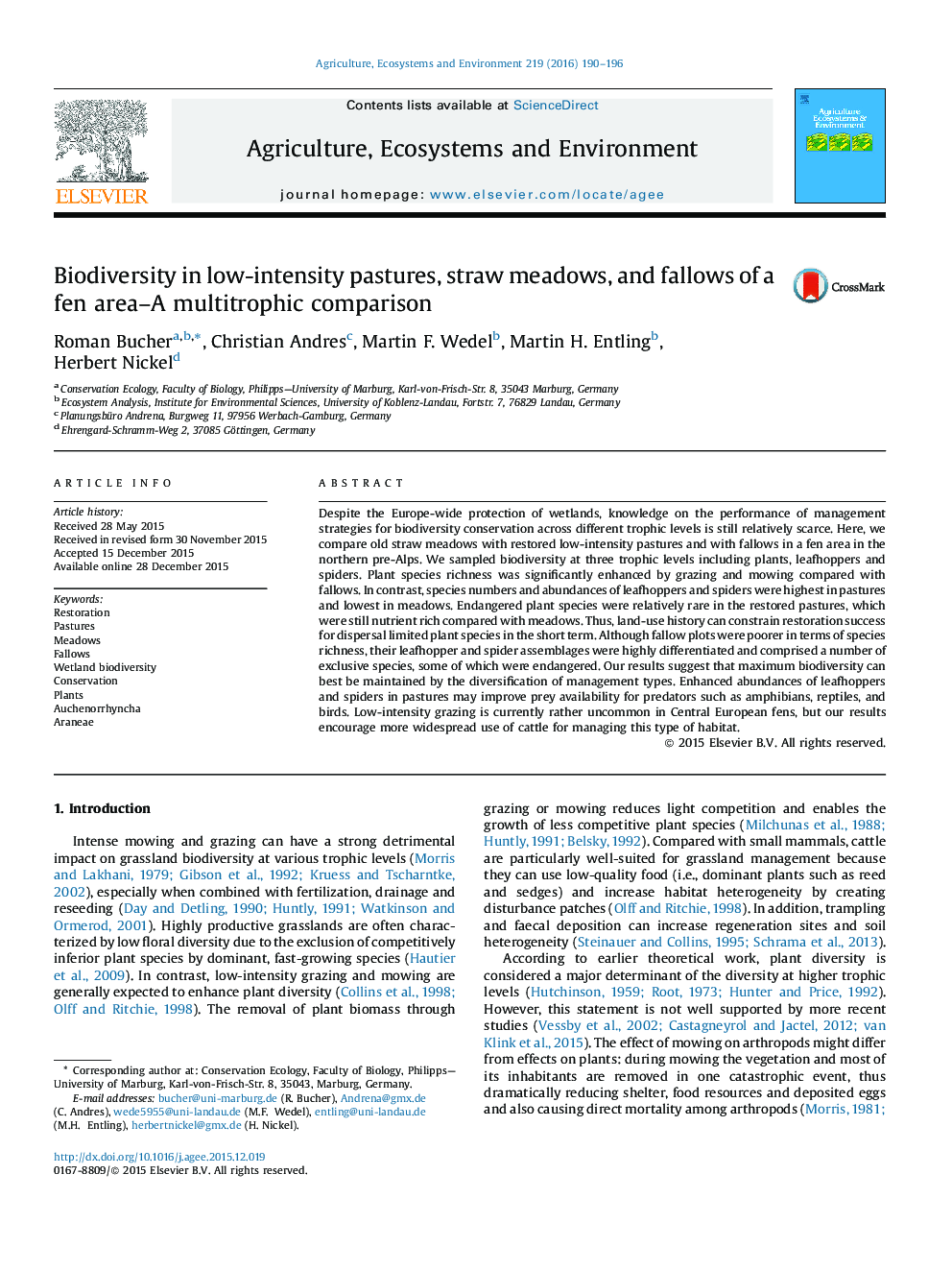| کد مقاله | کد نشریه | سال انتشار | مقاله انگلیسی | نسخه تمام متن |
|---|---|---|---|---|
| 8487534 | 1552033 | 2016 | 7 صفحه PDF | دانلود رایگان |
عنوان انگلیسی مقاله ISI
Biodiversity in low-intensity pastures, straw meadows, and fallows of a fen area-A multitrophic comparison
ترجمه فارسی عنوان
تنوع زیستی در مراتع کم چربی، مراتع نی و پارده های یک منطقه فن - یک مقایسه چند گانه
دانلود مقاله + سفارش ترجمه
دانلود مقاله ISI انگلیسی
رایگان برای ایرانیان
کلمات کلیدی
ترجمه چکیده
با وجود حفاظت از تالاب ها در سراسر اروپا، دانش در مورد عملکرد استراتژی های مدیریت برای حفاظت از تنوع زیستی در سطوح مختلف تنوع هنوز نسبتا کم است. در اینجا ما مراتع کوهستانی قدیمی را با مراتع مرطوب کم و با پارده در یک منطقه فن در شمال پیشاپال ها مقایسه می کنیم. ما تنوع زیستی را در سه سطح طوفانی از قبیل گیاهان، پوسترها و عنکبوتها نمونه برداری کردیم. غنای گونه گیاهی به طور قابل ملاحظه ای با چرا و چمن زنی در مقایسه با زراعت افزایش یافت. در مقابل، تعداد گونه ها و فراوانی برگ و عنکبوت بیشتر در مراتع و کمترین میزان در مراتع بوده است. گونه های گیاهی خطرناک در مراتع مرطوب، که هنوز در مقایسه با مراتع غنی از مواد مغذی هستند، نسبتا نادر بودند. بنابراین، تاریخچه استفاده از زمین می تواند موفقیت مرمت را برای محدود کردن گونه های گیاهی محدود در کوتاه مدت محدود کند. اگر چه توده های زراعی از لحاظ غنای گونه ای ضعیف تر بودند، گونه های برگرد و عنکبوت بسیار متفاوت بودند و شامل تعدادی گونه منحصر به فرد بودند که بعضی از آنها در معرض خطر بودند. نتایج ما نشان می دهد که بیشترین تنوع زیستی را می توان با تنوع بندی انواع مدیریت حفظ کرد. فراوانی های افزایش یافته از برگ و دمدمی مزاج در مراتع ممکن است دسترسی به شکار را برای شکارچیان مانند دوزیستان، خزندگان و پرندگان را بهبود بخشد. چراغ کم چربی در حال حاضر نسبتا کم در افسانه مرکزی اروپا است، اما نتایج ما باعث استفاده گسترده تر از گاو برای مدیریت این نوع زیستگاه می شود.
موضوعات مرتبط
علوم زیستی و بیوفناوری
علوم کشاورزی و بیولوژیک
علوم زراعت و اصلاح نباتات
چکیده انگلیسی
Despite the Europe-wide protection of wetlands, knowledge on the performance of management strategies for biodiversity conservation across different trophic levels is still relatively scarce. Here, we compare old straw meadows with restored low-intensity pastures and with fallows in a fen area in the northern pre-Alps. We sampled biodiversity at three trophic levels including plants, leafhoppers and spiders. Plant species richness was significantly enhanced by grazing and mowing compared with fallows. In contrast, species numbers and abundances of leafhoppers and spiders were highest in pastures and lowest in meadows. Endangered plant species were relatively rare in the restored pastures, which were still nutrient rich compared with meadows. Thus, land-use history can constrain restoration success for dispersal limited plant species in the short term. Although fallow plots were poorer in terms of species richness, their leafhopper and spider assemblages were highly differentiated and comprised a number of exclusive species, some of which were endangered. Our results suggest that maximum biodiversity can best be maintained by the diversification of management types. Enhanced abundances of leafhoppers and spiders in pastures may improve prey availability for predators such as amphibians, reptiles, and birds. Low-intensity grazing is currently rather uncommon in Central European fens, but our results encourage more widespread use of cattle for managing this type of habitat.
ناشر
Database: Elsevier - ScienceDirect (ساینس دایرکت)
Journal: Agriculture, Ecosystems & Environment - Volume 219, 1 March 2016, Pages 190-196
Journal: Agriculture, Ecosystems & Environment - Volume 219, 1 March 2016, Pages 190-196
نویسندگان
Roman Bucher, Christian Andres, Martin F. Wedel, Martin H. Entling, Herbert Nickel,
